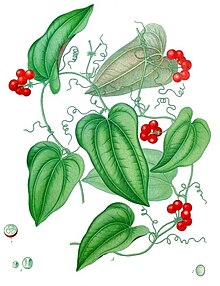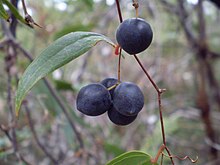Winds
| Winds | ||||||||||||
|---|---|---|---|---|---|---|---|---|---|---|---|---|

|
||||||||||||
| Systematics | ||||||||||||
|
||||||||||||
| Scientific name | ||||||||||||
| Smilax | ||||||||||||
| L. |
The stinging winds ( Smilax ), also called sarsaparilla or Sassaparilla , are a genus of plants in the family of stinging winds ( Smilacaceae ). The approximately 300 species are distributed almost worldwide.
description
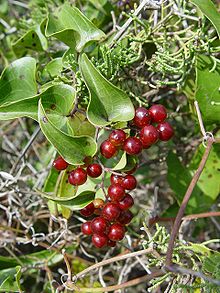
Appearance and leaves
Stingray species grow as splayed climbers and climbing with tendrils or - less often - as almost upright, sometimes perennial evergreen plants . Many species lignify and are shrubs , rarely semi-shrubs . Short, strong, thick rhizomes are usually formed as persistence organs . More or less woody, often quite long and more or less strongly branched, mostly prickly shoot axes (name!) Are formed. The leaves are often spiked as a climbing aid. Most species are dioecious.
The alternate and sometimes two-line leaves are divided into a petiole and a leaf blade. The leaf stalks, which are usually narrowly winged in the lower area, have an abscission zone (point where the leaf is thrown off) between the winged and upper (distal) area. The simple leaf blades are usually ovate to lanceolate and often have rounded or spear-shaped bases. There is a distinct network of nerves between the three to seven curved main nerves. There are often two tendrils at the base of the petiole .
Inflorescences and flowers
The inflorescences are lateral in foliage or scale-like bracts on inflorescence shafts, which sometimes have a scale-like propyll at their base . The paniculate , spike- like or racemose total inflorescence contains one to rarely three more or less cephalic umbilical partial inflorescences .
Stingray species are dioecious and separate sexes ( diocesan ). The relatively small, unisexual flowers are threefold. The two x three most free (at Smilax synandra overgrown), relatively small bracts are white to greenish. In the male flowers there are two circles with three free stamens each; rarely eight or more stamens present. The stamens are inserted at the base of the bracts. The dust bags usually only have one theka. Three carpels are fused together to form an upper three- chamber ovary. The ovary chambers each contain one or two ovules . There are three scars on a very short to barely recognizable stylus. There can be up to six staminodes in the female flowers .
Fruits and seeds
The berries, which are red to black when ripe , usually contain one to two, rarely up to three seeds. The dark brown seeds are smooth and shiny.
Systematics and distribution
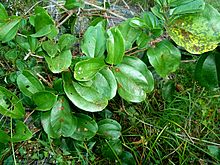

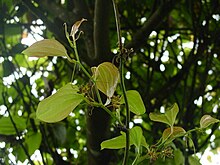





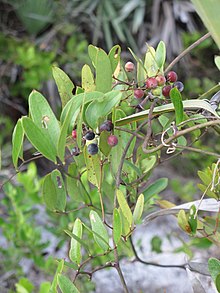




The genus Smilax was established by Carl von Linné . The generic name Smilax was used for an evergreen oak species in ancient Greece. A synonym for Smilax L. is Sarsaparilla Kuntze .
The Smilax species thrive in tropical, subtropical and temperate areas almost worldwide. About 79 species occur in China, 39 of them only there. Most species occur in the Neotropic . Only the three types of rough winds ( Smilax aspera ), Smilax canariensis and high winds ( Smilax excelsa ) also occur in Europe.
Depending on the author, there are 250 to 350 species in the genus of stinging winds ( Smilax ):
- Smilax aberrans Gagnep. : It occurs in southern China and northern Vietnam.
- Smilax aculeatissima Conran : This endemic occurs only in northern Queensland .
- Smilax amamiana Z.S.Sun & P.Li : This endemic occurs only on the Nansei Islands .
- Smilax amblyobasis K. Krause : It occurs in New Guinea .
- Smilax ampla Warb. ex K. Krause : It occurs in the Bismarck Archipelago .
- Smilax anceps Willd. (Syn .: Smilax kraussiana Meisn. ): It is widespread in tropical and southern Africa and on islands in the western Indian Ocean.
- Smilax anguina K. Krause : It occurs in New Guinea.
- Smilax annulata Warb. ex K. Krause : It occurs in New Guinea.
- Smilax aquifolium Ferrufino & Greuter : This endemic occurs only in western Cuba .
- Smilax arisanensis Hayata : It occurs in southern China, Taiwan and Vietnam.
- Veracruz torch ( Smilax aristolochiifolia Mill. ): It is distributed from southern Mexico to Honduras .
- Rough bindweed ( Smilax aspera L. ): It is common in Southern Europe , North Africa and the Orient ; it is one of the three species also found in Europe.
- Smilax aspericaulis Wall. ex A.DC. : The distribution area extends from the eastern Himalayas to southern China and the Philippines .
- Smilax assumptionis A.DC. : It occurs in eastern Bolivia , Paraguay and northeastern Argentina .
- Smilax astrosperma F.T.Wang & Tang : It thrives in open forests at altitudes from 0 to 1000 meters in the Chinese provinces of Guangxi and Hainan .
- Smilax auriculata Walter : It occurs from the southeastern United States to the Bahamas .
- Smilax australis R.Br. (Syn .: Smilax latifolia R.Br. , Smilax spinescens Miq. , Smilax latifolia var. Crassinervia A.DC. ): It occurs in northern and eastern Australia and on Lord Howe Island .
- Smilax austrozhejiangensis Q.Lin : It occurs in southern Zhejiang .
- Smilax azorica H. Schaef. & P.Schönfelder : It occurs in the Azores.
- Smilax bapouensis H.Li : It occurs in northwestern Yunnan .
- Smilax basilata F.T.Wang & Tang : It occurs in southeastern Yunnan and in Guangxi .
- Smilax bauhinioides Kunth : It occurs from southern Guangxi to southern Vietnam.
- Smilax bella J.F. Macbr. : It occurs in northern Peru .
- Smilax biflora Siebold ex Miq. : This endemic occurs only in Japanese ( Yakushima and Nansei-shoto ).
- Smilax biltmoreana (Small) JBNorton ex Pennell : It is found in the southeastern United States.
- Smilax binchuanensis P.Li & CXFu : It occurs in western Yunnan.
- Smilax biumbellata T.Koyama : It occurs from Assam to China.
- Smilax blumei A.DC. : It occurs from the Andamans to northern Queensland.
- Smilax bockii Warb. : It occurs from eastern Nepal to the Nansei Islands.
- Smilax bona-nox L .: It is distributed from the USA to Mexico and on Bermuda .
- Smilax borneensis A.DC. : It occurs on Borneo .
- Smilax bracteata C. Presl : It occurs from Japan to Indochina and the Carolines .
- Smilax brasiliensis Spreng. : It occurs in Brazil .
- Smilax californica (A.DC.) A.Gray : It occurs from southwest Oregon to northwest California .
- Smilax calophylla Wall. ex A.DC. : It occurs from Thailand to Sumatra and in Queensland.
- Smilax cambodiana Gagnep. : It occurs in Cambodia and southern Vietnam.
- Smilax campestris Griseb. : It occurs in Brazil, Paraguay, Uruguay and northern Argentina.
- Smilax canariensis Willd. : It occurs in the Canaries , the Azores and Madeira .
- Smilax canellifolia Mill .: It occurs from Cuba to Hispaniola and Jamaica .
- Smilax celebica flower : It occurs on Sulawesi .
- Smilax chapaensis Gagnep. : It occurs from southern China to northern Vietnam.
- Chinese bindweed ( Smilax china L. ): It is common in two varieties in China , Korea , Japan and Indochina ; with non-twisting, prickly stem, heart-shaped, rounded, short-pointed leaves and simple flower umbels, provides the so-called china root (smallpox root) in the bulbous rhizome . This tastes indifferent, then a bit scratchy, is odorless and especially contains smilacin. She came in 1525 by Vincent Gilius Tristan to Europe, was as a remedy for syphilis recommended and came to great fame because of the good effects which they where the gout -ridden Emperor Charles V exercised.
- Smilax chinensis (FTWang) P.Li & CXFu : It occurs only in China.
- Smilax chingii F.T.Wang & Tang : It occurs in southern China.
- Smilax cinnamomea Desf. ex A.DC. : It occurs in French Guiana .
- Smilax cissoides M. Martens & Galeotti : It occurs in Brazil.
- Smilax cocculoides Warb. : It occurs in southern China.
- Smilax cognata Kunth : It occurs from Brazil to Bolivia and Argentina.
- Smilax compta (Killip & CVMorton) Ferrufino : It occurs only in Panama .
- Smilax corbularia Kunth : It occurs in two varieties from southern China to western Malesia.
- Smilax cordato-ovata Rich. : It occurs in French Guiana.
- Smilax cordifolia Humb. & Bonpl. ex Willd. : It occurs in Mexico and Antigua .
- Smilax coriacea Spreng. : It occurs from Puerto Rico to the Virgin Islands .
- Smilax cristalensis Ferrufino & Greuter : It occurs in southeastern Cuba.
- Smilax cuprea Ferrufino & Greuter : This endemic occurs only in eastern Cuba.
- Smilax cuspidata Duhamel : It occurs in French Guiana.
- Smilax darrisii H.Lév. : It occurs in China.
- Smilax davidiana A.DC. : It occurs from Assam to southern China.
- Smilax densibarbata F.T.Wang & Tang : It occurs in southeastern Yunnan.
- Smilax discotis Warb. : It occurs in China.
- Smilax domingensis Willd. : It occurs from Mexico to tropical South America.
- Smilax ecirrhata (Engelm. Ex Kunth) S. Watson : It occurs from southern Ontario to the United States.
- Smilax elastica Griseb. : It occurs from eastern Bolivia to Brazil.
- Smilax elegans Wall. ex Kunth : It occurs in three subspecies from northern Pakistan to China.
- Smilax elegantissima Gagnep. : It occurs in southeastern Yunnan and in northern Vietnam.
- Smilax elmeri Merr. : It occurs in the Philippines.
- Smilax elongatoumbellata Hayata : It occurs in Taiwan and on the Nansei Islands .
- Smilax emeiensis J.M.Xu : It occurs in Sichuan .
- Smilax erecta Merr. : It occurs in the Philippines.
- High bindweed ( Smilax excelsa L. ): It occurs from the Balkan Peninsula to Iran.
- Smilax extensa Wall. ex Hook. f. : It occurs in Thailand and on the Malay Peninsula.
- Smilax ferox Wall. ex Kunth : The distribution area extends from Nepal to southern China.
- Smilax flavicaulis Rusby : It occurs in Bolivia.
- Smilax fluminensis Steud. : It occurs from Costa Rica to Argentina.
- Smilax fooningensis F.T.Wang & Tang : It occurs in southeastern Yunnan.
- Smilax fortunensis Ferrufino & Gómez-Laur : It occurs only in Panama.
- Smilax fui Z.C.Qi & P.Li : This endemic occurs only on the Nansei Islands.
- Smilax gagnepainii T.Koyama : It occurs in China and Vietnam.
- Smilax gaudichaudiana Kunth : It occurs in China, Taiwan and Vietnam.
- Smilax gigantea Merr. : It occurs on Borneo.
- Smilax gigantocarpa Koord . : This endemic occurs in Java .
- Smilax glabra Roxb. : The distribution area extends from Assam and to Taiwan and Indochina.
- Smilax glauca Walter : It is distributed from the USA to Mexico.
- Smilax glaucochina Warb. ex Diels : It occurs in China and Taiwan.
- Smilax glyciphylla Sm . : It occurs in Queensland and New South Wales .
- Smilax goyazana A.DC. : It occurs in Bolivia, Brazil and Paraguay.
- Smilax gracilior Ferrufino & Greuter : It occurs in Cuba and the Bahamas.
- Smilax griffithii A.DC. : It occurs from the eastern Himalayas to Thailand.
- Smilax guianensis Vitman : It occurs from Puerto Rico to Venezuela.
- Smilax guiyangensis C.X.Fu & CDShen : It occurs in Guizhou .
- Smilax havanensis Jacq. : It occurs from southern Florida to the northern Caribbean.
- Smilax hayatae T.Koyama : It occurs in Guangdong and Taiwan.
- Smilax hemsleyana Craib : It occurs from Assam to China.
- Smilax herbacea L .: It is distributed from eastern Canada to the eastern United States.
- Smilax hilariana A.DC. : It occurs in southeastern Brazil.
- Smilax hirtellicaulis C.Y.Wu & C.Chen ex P.Li : It was first described in 2016 from Yunnan.
- Smilax horridiramula Hayata : This endemic occurs only in Taiwan.
- Smilax hugeri (Small) JBNorton ex Pennell : It is found in the southeastern United States.
- Smilax hypoglauca Benth. : It occurs in Borneo and in southeastern China.
- Smilax ilicifolia Desv. ex Ham. : It occurs on Hispaniola.
- Smilax illinoensis Mangaly : It occurs from southern Ontario to the central and eastern United States.
- Smilax indosinica T.Koyama : It occurs in Thailand.
- Smilax inversa T.Koyama : It occurs in Thailand, Cambodia, Laos , Vietnam and Malaysia.
- Smilax irrorata Mart. ex Griseb. : It occurs in tropical South America.
- Smilax jamesii G.A. Wallace : This endemic is only found in northwestern California .
- Smilax japicanga Griseb. : It is common in southeastern Brazil.
- Smilax javensis A.DC. : This endemic only occurs on Java.
- Smilax kaniensis K. Krause : It occurs from New Guinea to northern Queensland.
- Smilax keyensis Warb. ex K.Krause : This endemic occurs in Maluku .
- Smilax kingii Hook. f. : It occurs in the eastern Himalayas and on the Malay Peninsula.
- Smilax klotzschii Kunth : It occurs in Java.
- Smilax korthalsii A.DC. : It occurs in Borneo.
- Smilax kwangsiensis F.T.Wang & Tang : It occurs in two varieties in Guangxi and Guangdong.
- Smilax lanceifolia Roxb. : It occurs in four varieties from Nepal to Taiwan and western Malesia .
- Smilax lappacea Humb. & Bonpl. ex Willd. : It occurs from Venezuela to Peru and Brazil.
- Smilax larvata Griseb. : It occurs in Brazil.
- Smilax lasioneura Hook. : It occurs in Canada and the United States.
- Smilax laurifolia L .: It is native to the south-eastern USA to eastern Texas , the Bahamas and Cuba .
- Smilax lebrunii H.Lév. : It occurs in China and Myanmar .
- Smilax leucophylla flower : It occurs from Indochina to New Guinea.
- Smilax ligneoriparia C.X.Fu & P.Li : It occurs in Yunnan and Zhejiang .
- Smilax ligustrifolia A.DC. : This endemic occurs only in New Caledonia .
- Smilax loheri Merr. : This endemic occurs only on Luzon .
- Smilax longiflora (KYGuan & Noltie) P.Li & CXFu : It occurs in southern Yunnan.
- Smilax longifolia Rich. (Syn .: Smilax papyracea Duhamel , Smilax acuminata Willd. , Smilax flavescens Desv. Ex Ham. , Smilax syphilitica Mart. Nom. Illeg., Smilax longifolia var. Variegata B.S.Williams , Smilax officinalis Poepp. Ex A.DC. nom. Inval . non Kunth , Sarsaparilla acuminata (Willd.) Kuntze ): The distribution area is Hispaniola and tropical South America .
- Smilax lucida Merr. : This endemic occurs only on Luzona .
- Smilax luei T.Koyama : This endemic occurs only in central Taiwan.
- Smilax lunglingensis F.T.Wang & Tang : It occurs in Yunnan.
- Smilax lushuiensis S.C.Chen : It occurs in western Yunnan.
- Smilax lutescens Vell. : It occurs in southeastern Brazil.
- Smilax luzonensis C. Presl : It occurs from India to the Philippines.
- Smilax macrocarpa flower : This endemic occurs only on Java.
- Smilax magnifolia J.F. Macbr. : It occurs in northern Peru.
- Smilax mairei H.Lév. : It occurs in Yunnan.
- Smilax malipoensis S.C.Chen : It occurs in southeastern Yunnan.
- Smilax maritima Feay ex Alph.Wood : It occurs from the southeastern United States to southeast Texas.
- Smilax maypurensis Humb. & Bonpl. ex Willd. : It occurs in tropical South America.
- Smilax megacarpa A.DC. : It occurs from Assam to China and Malesia.
- Smilax megalantha C.H.Wright : It occurs in China and Myanmar.
- Smilax melanocarpa Ridl. : It occurs in New Guinea.
- Smilax melastomifolia Sm. (Syn .: Smilax sandwicensis Kunth , Smilax hawaiensis Seem. ): The home is Hawaii .
- Smilax menispermoidea A.DC. : It occurs from the Himalayas to China.
- Smilax micrandra (T.Koyama) P.Li & CXFu : This endemic occurs only in southern Hainan .
- Smilax microchina T.Koyama : It occurs in northeastern Thailand.
- Smilax microdontus Z.S. Sun & CXFu : First described in 2015 from China.
- Smilax microphylla C.H.Wright : It occurs in China.
- Smilax minarum A.DC. : It occurs in Brazil.
- Smilax minutiflora A.DC. : It occurs from Nepal to Bangladesh .
- Smilax modesta A.DC. : It occurs on Borneo, Java and Sumatra.
- Smilax mollis Humb. & Bonpl. ex Willd. : It occurs in western Cuba and from Mexico to Ecuador and Venezuela.
- Smilax moranensis M. Martens & Galeotti : It occurs from Mexico to Nicaragua.
- Smilax munita S.C.Chen (Syn .: Smilax rigida Wall. ): It iswidespreadfrom Nepal to Yunnan .
- Smilax muscosa Toledo : It occurs in southeastern Brazil.
- Smilax myosotiflora A.DC. : It occurs in Myanmar, Thailand, Malaysia and northwest Borneo.
- Smilax myrtillus A.DC. : It occurs from Bhutan to Yunnan.
- Smilax nageliana A.DC. : It occurs on Java.
- Smilax nana F.T.Wang : It occurs in western Yunnan.
- Smilax nantoensis T.Koyama : This endemic is only found in Taiwan.
- Smilax neocaledonica Schltr. : This endemic occurs only in New Caledonia.
- Smilax neocyclophylla I.M.Turner (Syn .: Smilax cyclophylla Warblers. ): It occurs in south-central China.
- Smilax nervomarginata Hayata : It occurs in southeastern China and on the Nansei Islands.
- Smilax nigrescens F.T.Wang & Tang : It occurs in central China.
- Smilax nipponica Miq. : It occurs in China, Japan, Korea and Taiwan.
- Smilax nova-guineensis T.Koyama : It occurs from New Guinea to the Bismarck Archipelago.
- Smilax obliquata Duhamel : It occurs in Peru.
- Smilax oblongata Sw. : It occurs from the Lesser Antilles to northern South America.
- Smilax oblongifolia Pohl ex Griseb. : It occurs in Brazil.
- Smilax ocreata A.DC. : It occurs from the Himalayas to Hainan.
- Smilax odoratissima flower : It occurs from Bangladesh to western Malesia.
- Smilax officinalis Kunth non Griseb. non Poepp. ex A.DC. (Syn .: Smilax bernhardii F.W.Apt , Smilax gilgiana F.W.Apt , Smilax tonduzii F.W.Apt , Smilax vanilliodora F.W.Apt , Smilax barbillana Cufod. , Smilax standleyi Killip & CVMorton , Smilax chiriquensis C.V.Morton ): It is from Honduras to Ecuador widespread.
- Smilax orbiculata Labill. : This endemic occurs only in New Caledonia.
- Honduras torch ( Smilax ornata Lem. , Syn .: Smilax grandifolia Regel nom. Illeg., Smilax utilis Hemsl. Nom. Illeg. Non CHWright , Smilax Regelii Killip & CVMorton , Smilax Regelii var. Albida Killip & CVMorton ): She is from Mexico spread to Central America .
- Smilax orthoptera A.DC. : It occurs from Nepal to Myanmar.
- Smilax outanscianensis Pamp. : It occurs in China.
- Smilax ovalifolia Roxb. ex D.Don : It occurs from the Himalayas to Hainan.
- Smilax ovatolanceolata T.Koyama : It occurs in Borneo.
- Smilax pachysandroides T.Koyama : It occurs in Sichuan and Hubei.
- Smilax paniculata (Gagnep.) P.Li & CXFu : It occurs in Cambodia and Vietnam.
- Smilax papuana Lauterb. : It occurs in Papua New Guinea .
- Smilax perfoliata Lour. : It occurs from the Indian subcontinent to Taiwan.
- Smilax petelotii T.Koyama : It occurs in China and northern Vietnam.
- Smilax pilcomayensis Guagl. & Gattuso : It occurs in Bolivia, Brazil, Argentina and Paraguay.
- Smilax pilosa Andreata & Leoni : It occurs in Brazil.
- Smilax pinfaensis H.Lév. & Vaniot : It occurs in Guizhou.
- Smilax plurifurcata A.DC. : This endemic occurs only in New Caledonia.
- Smilax poilanei Gagnep. : It occurs in Vietnam.
- Smilax polyacantha Wall. ex Kunth : It occurs in Assam, on the Andamans and in Malaysia.
- Smilax polyandra (Gagnep.) P.Li & CXFu : It occurs from Assam to Yunnan.
- Smilax polyantha Griseb. : It occurs from Brazil to Bolivia.
- Smilax polycolea Warb. : It occurs in southern China.
- Smilax populnea Kunth : It occurs in Hispaniola.
- Smilax pottingeri Prain (Syn .: Smilax jiankunii H.Li ): It occurs from Assam to Yunnan and northern Indochina.
- Smilax pseudochina L .: It occurs from New York to Georgia .
- Smilax pulverulenta Michx. : It occurs in the north-central and eastern United States.
- Smilax pumila Walter : It occurs from the southeastern United States to eastern Texas.
- Smilax purhampuy Ruiz (Syn .: Smilax febrifuga Kunth , Smilax ruiziana Kunth ): It is widespread from Central to tropical South America.
- Smilax purpurata G. Forest. : This endemic occurs only in New Caledonia.
- Smilax pygmaea Merr. : It occurs from Taiwan to the northern Philippines.
- Smilax quadrata A.DC. : It occurs from Assam to Yunnan.
- Smilax quadrumbellata T.Koyama : It occurs in India.
- Smilax quinquenervia Vell. (Syn .: Smilax officinalis Griseb. Nom. Illeg. Non Kunth , Smilax procera Griseb. , Smilax pohliana Kunth , Smilax tijucensis A.DC. ): It occurs in tropical South America.
- Smilax remotinervis hand.-Mazz. : It occurs in eastern Brazil.
- Smilax retroflexa (FTWang & Tang) SCChen : It occurs in China and Vietnam.
- Smilax riparia A.DC. : It is distributed with several varieties from China to the Philippines .
- Round-leaved bindweed ( Smilax rotundifolia L. ): It is common in Canada and the USA.
- Smilax roxburghiana Wall. ex A.DC. : It occurs from the eastern Himalayas to Assam.
- Smilax rubromarginata K. Krause : It occurs in New Guinea.
- Smilax rufescens Griseb. : It occurs from southern Venezuela to Brazil and Bolivia.
- Smilax salicifolia Griseb. : It occurs in the southeast of Brazil.
- Smilax sanguinea Posada-Ar. : It occurs in Colombia .
- Smilax santaremensis A.DC. : It occurs in Brazil, Suriname, Guiana and French Guiana.
- Smilax saulensis J.D.Mitch. : It occurs in French Guiana.
- Smilax schomburgkiana Kunth : It occurs from Trinidad to tropical South America.
- Smilax scobinicaulis C.H.Wright : It occurs in China.
- Smilax sebeana Miq. : It occurs in Japan on the Nansei Islands and on Taiwan.
- Smilax seisuiensis (Hayata) P.Li & CXFu : This endemic occurs only in Taiwan.
- Smilax septemnervia (FTWang & Tang) P.Li & CXFu : It occurs from southern China to Vietnam.
- Smilax setiramula F.T.Wang & Tang : It occurs in southeastern Yunnan.
- Smilax setosa Miq. : It occurs in Malaysia, Borneo and Sumatra.
- Smilax Sieboldii Miq. : It is common in China and East Asia.
- Smilax silverstonei Botina : It occurs in Colombia.
- Smilax sinclairii T.Koyama : It occurs on the Malay Peninsula.
- Smilax siphilitica Humb. & Bonpl. ex Willd. : It occurs from the Lesser Antilles to tropical South America.
- Smilax solanifolia A.DC. : It occurs from the Lesser Antilles to northern South America.
- Smilax spicata Vell. : It occurs in southeastern Brazil.
- Smilax spinosa Mill .: It occurs from Mexico and Trinidad to tropical South America.
- Smilax spissa Killip & CVMorton : It occurs from southern Costa Rica to Panama.
- Smilax spruceana A.DC. : It occurs in northern Brazil.
- Smilax stans Maxim. : It occurs in China, Japan and Taiwan.
- Smilax stenophylla A.DC. : It occurs in Brazil.
- Smilax subinermis C. Presl : It occurs in Peru.
- Smilax subpubescens A.DC. : It occurs from Mexico to Central America.
- Smilax subsessiliflora Duhamel : It occurs in eastern Brazil.
- Smilax sumatrensis (A.DC.) P.Li & CXFu : It occurs in Thailand, Malaysia, Sumatra, Borneo, Cambodia, Laos and Vietnam.
- Smilax synandra Gagnep. : It occurs from northeastern Thailand to China.
- Smilax talbotiana A.DC. : It occurs in Guyana .
- Stiff-bristled bindweed ( Smilax tamnoides L. ): It is common in the USA, Ontario and northeastern Mexico.
- Smilax tetraptera Schltr. : This endemic occurs only in New Caledonia.
- Smilax timorensis A.DC. : This endemic occurs only in Timor .
- Smilax tomentosa Kunth : It occurs from southern Mexico and western South America to northwestern Venezuela.
- Smilax trachypoda J.B. Norton : It occurs in central China.
- Smilax trinervula Miq. : It occurs from southern China to Honshu.
- Smilax tsinchengshanensis F.T.Wang : It occurs in Sichuan and Guizhou.
- Smilax tuberculata C. Presl : It occurs in Ecuador.
- Smilax turbans F.T.Wang & Tang : It occurs from the eastern Himalayas to Assam.
- Smilax utilis C.H. Wright non Hemsl. : This endemic occurs only in the Solomon Islands .
- Smilax vaginata Decne. : It is spread from Afghanistan to Assam.
- Smilax vanchingshanensis (FTWang & Tang) FTWang & Tang : It occurs in China.
- Smilax velutina Killip & CVMorton : It occurs from Mexico to Panama.
- Smilax verrucosa Griseb. : It occurs in Brazil and Uruguay.
- Smilax verticalis Gagnep. : It occurs in Thailand, Cambodia, Laos and Vietnam.
- Smilax vitiensis (Seem.) A.DC. : It occurs on islands in the southwestern Pacific.
- Smilax wallichii Kunth : It occurs in the eastern Himalayas.
- Smilax walteri Pursh : It is distributed from the southeastern USA to Texas.
- Smilax wightii A.DC. : It is common in the Himalayas, India and Nepal.
- Smilax williamsii Merr. : It occurs in the Philippines.
- Smilax yunnanensis S.C.Chen : It occurs in southern Yunnan.
- Smilax zeylanica L .: It occurs in tropical Asia.
use

food industry
Varieties of Smilax are found in varieties of root beer and similar beverages. In Southeast Asia there is the drink sarsi , which is made with the help of the plant extract .
Naturopathy
The drug under the name Sarsaparille, Radix Sarsaparillae from the subterranean parts of plants of, for example, Smilax chinensis (Chinese windlass), Smilax officinalis , Smilax aristolochiifolia (Veracruz windlass), Smilax ornata (Honduras windlass was used earlier in the treatment of Smilax siphilica ) and Smilax siphilica of syphilis . Occasionally, for example, as a "blood cleanser", urinary and sweaty agent, for chronic inflammatory skin diseases. Sarsaparilla ("Sars.") Is still used occasionally in homeopathic terms. The saponins contained are responsible for undesirable effects such as stomach and kidney irritation. None of the effects have been scientifically proven.
Mention of sarsaparilla in literature and others
- Sarsaparilla is the Smurfs' favorite food . The fruits are usually referred to as smurfberries in German translations.
- Sunset Sarsaparilla is a soft drink in Fallout: New Vegas , a computer game from the Fallout series .
- Sarsaparillas are mentioned as a drink on p. 309 and p. 317 of the book Ways of Fate by Penelope Williams.
- Sarsaparillextrakt George Cyril Wellbeloved as thirst-quenching alternative to the banned alcohol in the novel is pork or non-pig ( have Pigs Wings ) by PG Wodehouse offered.
- The innkeepers of the invisible in HG Wells ' novel The Invisible put their beer with sarsaparilla.
- In The Big Lebowski , Sam Elliott's character (The Stranger) orders a Sioux City Sarsaparilla from the bowling alley bar .
swell
- Chen Xinqi (陈心启), Tetsuo Koyama: Smilax. - online with the same text as the printed work . In: Wu Zheng-yi, Peter H. Raven (Ed.): Flora of China . Volume 24: Flagellariaceae through Marantaceae . Science Press / Missouri Botanical Garden Press, Beijing / St. Louis 2000, ISBN 0-915279-83-5 , pp. 96 (English).
- Walter C. Holmes: Smilax. - same text online as the printed work. In: Flora of North America Editorial Committee (Ed.): Flora of North America North of Mexico . Volume 26: Magnoliophyta: Liliidae: Liliales and Orchidales . Oxford University Press, New York / Oxford a. a. 2002, ISBN 0-19-515208-5 , pp. 468 (English).
- L. Ferrufino-Acosta: Taxonomic revision of the genus Smilax (Smilacaceae) in Central America and the Caribbean islands. In: Willdenowia , Volume 40, 2010, pp. 227-280. doi: 10.3372 / wi.40.40208
Individual evidence
- ↑ a b c d e f g h i j k l m n o p q r s t u v w x y z aa ab ac ad ae af ag ah ai aj ak Chen Xinqi, Tetsuo Koyama: Smilax. - online with the same text as the printed work . In: Wu Zheng-yi, Peter H. Raven (Ed.): Flora of China . Volume 24: Flagellariaceae through Marantaceae . Science Press / Missouri Botanical Garden Press, Beijing / St. Louis 2000, ISBN 0-915279-83-5 , pp. 96 (English).
- ↑ a b c d e f g h i j k l Robert Anthony DeFilipps: Smilax L. , p. 74. In: TG Tutin, VH Heywood, NA Burges, DM Moore, DH Valentine, SM Walters, DA Webb (eds. ): Flora Europaea . Volume 5: Alismataceae to Orchidaceae (Monocotyledones) . Cambridge University Press, Cambridge 1980, ISBN 0-521-20108-X , pp. 74 (English, limited preview in Google Book Search).
- ^ A b Walter C. Holmes: Smilax. - Same text online as the printed work , In: Flora of North America Editorial Committee (Ed.): Flora of North America North of Mexico . Volume 26: Magnoliophyta: Liliidae: Liliales and Orchidales . Oxford University Press, New York / Oxford a. a. 2002, ISBN 0-19-515208-5 , pp. 468 (English).
- ↑ a b c d e f g h i j k l m n o p q r s t u v w x y z aa ab ac ad ae af ag ah ai aj ak al am an ao ap aq ar as at au av aw ax ay az ba bb bc bd be bf bg bh bi bj bk bl bm bn bo bp bq br bs bt bu bv bw bx by bz ca cb cc cd ce cf cg ch ci cj ck cl cm cn co cp cq cr cs ct cu cv cw cx cy cz da db dc dd de df dg dh di dj dk dl dm dn do dp dq dr ds dt du dv dw dx dy dz ea eb ec ed ee ef eg eh ei ej ek el em en eo ep eq er es et eu ev ew ex ey ez fa fb fc fd fe ff fg fh fi fj fk fl fm fn fo fp fq fr fs ft fu fv fw fx fy fz ga gb gc gd ge gf gg gh gi gj gk gl gm gn go gp gq gr gs gt gu gv gw gx gy gz ha hb hc hd he hf hg hh hi hj hk hl hm hn ho hp hq hr hs ht hu hv hw hx hy hz ia ib ic id ie if ig ih ii Rafaël Govaerts (Ed.) : Smilax. In: World Checklist of Selected Plant Families (WCSP) - The Board of Trustees of the Royal Botanic Gardens, Kew . Retrieved July 2, 2018.
- ↑ Smilax in the Germplasm Resources Information Network (GRIN), USDA , ARS , National Genetic Resources Program. National Germplasm Resources Laboratory, Beltsville, Maryland.
- ↑ a b c d e f g Walter Erhardt , Erich Götz, Nils Bödeker, Siegmund Seybold: The great pikeperch. Encyclopedia of Plant Names. Volume 2. Types and varieties. Eugen Ulmer, Stuttgart (Hohenheim) 2008, ISBN 978-3-8001-5406-7 .
- ↑ Sassaparilla . In: Merck's Warenlexikon . 3rd ed. 1884 ff., P. 489 f.
- ^ Hunnius Pharmaceutical Dictionary, 8th edition, Berlin 1997
- ↑ Homeopathic Repertory, Karlsruhe 2002, Deutsche Homöopathie Union.
- ↑ Brown, Frohnenberg: medicinal plants lexicon , Gustav Fischer Verlag, Stuttgart, Jena, New York, 6th ed 1994th
Historical literature
- Winds . In: Meyers Konversations-Lexikon . 4th edition. Volume 14, Verlag des Bibliographisches Institut, Leipzig / Vienna 1885–1892, p. 1036.
